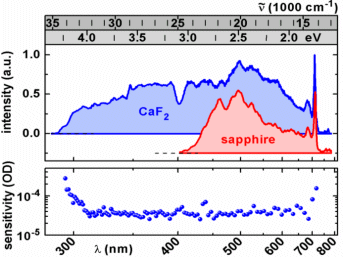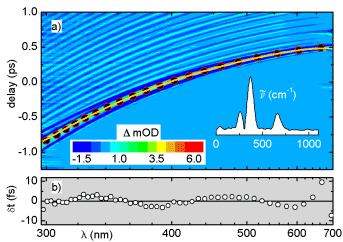|
Pump probe spectroscopy of molecular dynamics calls for temporal and spectral resolution as high as possible.
To fulfill these requirements we designed a modular sub-50 fs broadband absorption spectrometer based on a
noncollinear parametric amplifier (NOPA) as pump
and a CaF2 white light as probe. The full potential of the broad supercontinuum can be best exploited
with a multichannel detection system operating at the laser repetition rate of 1kHz. In contrast to the standard
approach, our spectrometer does not require the detection of a reference beam to account for the shot-to-shot
fluctuations in the white light. Using a single shot detection, we exploit the high correlation between successive pulses for
the normalization of the probe intensity. The resulting high detection sensitivity of better than ΔOD = 10-4
offeres a dynamic range of 1000:1 and allows us to observe molecular dynamics over many time constants and for species
with strongly differing transition strengths.
Flow cells with 200 µm windows and down to 120 µm sample thickness reduce the coherent artifact and the group
velocity mismatch. To disperse the supercontinuum, a prism based polychromator is employed to avoid the order sorting
problem with the more than octave wide probe spectrum and to enhance the throughput. The resulting spectral resolution
lies between 50 and 100 cm-1. In our lab we use two types of multichannel detection systems which are
operated at the laser repetition rate of 1 kHz: a photodiode array (PDA)
based camera (tec5 AG) and a back-thinned full frame transfer CCD camera (Ingineurbüro Stresing) which we find both
equally suitable.
White light generation in Calcium flouride
As many organic molecules have their lowest transitions in the UV it is helpful to have probe photons at these wavelengths.
The commonly used sapphire continuum obtained with the Ti:Sa fundamental at 775 nm spans from about 420 nm to 720 nm. The
spectrum of a white light generated in a 5 mm CaF2 plate extends from 290 to 720 nm and shows an almost flat plateau.
As strong spectral modulations and temporal fluctuations are present near the fundamental, we use a custom made mirror
to block this region.
In the range from 300-700 nm, the energy density is ~10 pJ/nm and the intensity modulation even is less than a factor of three.
The even distribution of the intensity allows for measurements with a high dynamic range and makes the CaF2 continuum
an ideal probe.
The detection sensitivity can be determined from a statistical analysis of the signal before time zero. A typical measurement
with 2'000 averages per spectrum returns a standard deviation, i.e. a detection sensitivity of the instrument of 1x10-4 OD over
the whole spectral range. With 10 scans and 2000 averages for each we can even reach an average sensitivity of 4.6x10-5 OD, some
spectral regions being even a factor of 4 better.
Dispersion correction and time resolution
Due to the chirp of the white light the temporal overlap between pump and probe or time zero is wavelength dependent.
This can be seen in the figure below which shows the raw transient absorption of chloroform excited at 600 nm. The nominal delay of 0 fs
is arbitrarily set at 400 nm. The temporal overlap of a certain component of the continuum with the pump pulse results in a coherent
artifact. Its position (circles) reveals that there is a ~1.5 ps temporal dispersion between 300 and 750 nm, in good agreement with the
calculated group velocity dispersion due to the optical components in the probe beam. To obtain the transient spectrum at a chosen
delay time the raw data have to be corrected for the chirp which is best carried out after the measurement.
The proper chirp correction requires an accurate determination of the time zero.
When using common solvents such as ethanol, acetonitrile or DMSO, the determination of the time zero point is most easily done using
the coherent artifact. This method yields time zero typically with an error of less then ±5 fs.
The time resolution of the instrument can be estimated from the Fourier transform spectrum of the Raman active oscillations in the
chloroform transients. The 669 cm-1 mode, corresponding to a vibrational period of 50 fs, is clearly resolved throughout the
observed spectral window. We can therefore estimate the actual time resolution that can routinely be achieved with our setup to be below 50 fs.
Data processing and analysis
The availability of a 2D data set from the multichannel detection permits and requires sophisticated post processing software for chirp
correction, wavelength calibration and the extraction of molecular dynamics.
The analysis we perform does not just aim at the full parametrization of the obtained data but rather follows a spectroscopy
oriented approach. That means we use the available knowledge, e.g., from own steady state measurements or the literature to
stepwise gain full insight into the mechanisms of the ultrafast processes on the molecular level. The quality of the final
picture is closely related to the understanding and correct implementation of the technical and spectroscopic concepts.
If you are interested in our software package, please contact the authors.
|




